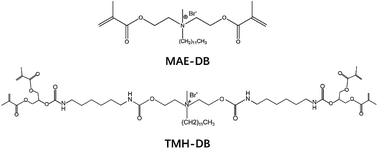Antibacterial and thermomechanical properties of experimental dental resins containing quaternary ammonium monomers with two or four methacrylate groups
Abstract
Resins with strong antibacterial and thermomechanical properties are critical for application in oral cavities. In this study, we first evaluated the antibacterial effect of an unfilled resin incorporating 1, 4, and 7 mass% of quaternary ammonium salt (QAS) monomers containing two methacrylate groups (MAE-DB) and four methacrylate groups (TMH-DB) against Streptococcus mutans, and tested the cytotoxicity and thermomechanical properties of the 4 mass% MAE-DB and TMH-DB modified resin materials. A neat resin without a QAS monomer served as the control. As the concentration of both QAS monomers increases, the formation of a Streptococcus mutans biofilm on the experimental material is increasingly inhibited. The results of colony forming unit counts and the metabolic activity showed that both the MAE-DB and TMH-DB modified resins have a strong bactericidal effect on the bacteria in a biofilm, but no bactericidal effect on the bacteria in a solution. The viability-staining and morphology results also demonstrate that the bacteria deform, lyse, shrink, and die on the surface of the two QAS-modified resins. Cytotoxicity results show that the addition of TMH-DB can reduce the cytotoxicity of the resin, while the addition of MAE-DB increases the cytotoxicity of the resin. DMA results show that a TMH-DB modified resin has a higher storage modulus than a MAE-DB modified resin owing to its better crosslink density. The two groups of experimental resins showed a similar glass transition temperature. These data indicate that the two QAS monomers can impart similar antibacterial properties upon contact with a dental resin, whereas TMH-DB can endow the resin with a higher crosslink density and storage modulus than MAE-DB because it has more polymerizable groups.



 Please wait while we load your content...
Please wait while we load your content...